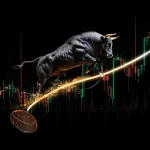
What Type of Trader Are You: Speedy Rabbit or Steady Turtle?
May 16, 2024
In the world of trading, the metaphor of the fast rabbit and the steady turtle is a timeless tale that offers profound insights into the psychology and strategies of market participants. The story of Reckless the Rabbit and Tenacious the Turtle, inspired by Aesop’s Fables, is a powerful allegory for understanding different trading styles and the importance of patience, discipline, and mass psychology in achieving long-term success.
The Tale of Reckless and Tenacious
Once upon a time, a rabbit named Reckless was always boasting about how fast he could run. He criticized all the other animals, especially the smaller ones, saying they were slower and lazier and could never beat him. He was particularly harsh on a turtle named Tenacious, bullying him constantly. Reckless would say ugly, nasty words to Tenacious, who just sat there daily, appearing to let the words roll off his shell.
But enough was enough. Finally, Tenacious got fed up. He stuck his head out of his shell, looked up at Reckless, and said, “Who do you think you are anyway? Why are you always bragging about how fast you are? I am sick and tired of hearing this abuse from you.”
Reckless smirked, looked down at Tenacious, and squealed with laughter. “Nobody can beat me. Especially you—since you are slower than molasses. Bring it on if you want to race because you don’t have a chance. I will win, no matter how hard you try.”
“It’s on,” said Tenacious. “We’ll race tomorrow at the crack of dawn.”
The next day came, and Reckless and Tenacious showed up ready to go. The racecourse was all laid out, and they both stood on the starting line. Reckless was cocky and confident as he watched Tenacious move slowly along the path. Reckless had been up most of the night partying with the other rabbits, so he was sleep-deprived and decided to take a nap.
Reckless woke from a fitful sleep and gazed around, looking for Tenacious. Slowly and steadily moving forward, Tenacious was about a third of the way to the finish line. Breathing a sigh of relief, Reckless decided he was hungry and had lots of time to eat. The heavy meal and the hot sun made his eyelids droop. With a glance at Tenacious—now halfway along the course—he took another quick nap before running past the turtle to beat him to the finish line.
The nap turned into a longer sleep, and when Reckless woke up, the sun was beginning to set. Reckless jumped up in alarm and saw that Tenacious was almost at the finish line. Reckless bolted as fast as he could, gasping for breath, leaping high into the air, giving it everything he had. Too bad. Too late. Tenacious beat Reckless.
Lessons from Aesop: Slow and Steady Wins the Trading Race
This rendition of Aesop’s Fable teaches us that slow and steady wins the race. Many traders come to the markets to make huge profits by doing very little or getting rich quickly. They are like Reckless the Rabbit, who thinks he can win with the least amount of work possible. They don’t understand that consistent market winning has to do with slow and steady gains. The real secret of winning is to get rich slowly. This is done by striking out (taking stops and small losses), hitting some singles and doubles (taking more significant profits regularly), and occasionally hitting home runs.
Choosing the Right Trading Style: Understanding the Various Types of Traders
In the trading world, there are different styles and approaches, each with its advantages and challenges. The fast rabbit represents the crowd—those who chase quick profits, follow trends, and often succumb to the emotional highs and lows of the market. On the other hand, the steady turtle symbolizes the individual trader who uses mass psychology to go against the crowd, relying on patience, discipline, and a long-term perspective.
The Fast Rabbit: Chasing Quick Profits
Fast rabbits are traders who seek to capitalize on short-term market movements. They are often driven by the fear of missing out (FOMO) and the desire for quick gains. This trading style can be enriching during periods of market momentum, but it also carries significant risks. Overconfidence, lack of discipline, and susceptibility to emotional swings can lead to substantial losses.
The Steady Turtle: Embracing Patience and Discipline
Steady turtles, in contrast, focus on long-term gains and are less influenced by short-term market fluctuations. They understand the importance of patience, discipline, and self-reflection. By going against the crowd and using mass psychology, they can identify opportunities others might overlook. This approach requires a deep understanding of market dynamics and the ability to remain calm and composed during periods of volatility.
The Value of Technical Analysis
Technical analysis is a crucial tool for both fast rabbits and steady turtles. It involves analyzing historical price data and market trends to make informed trading decisions. Technical analysis can help traders identify entry and exit points, understand market sentiment, and manage risk effectively.
While technical analysis provides valuable insights into market trends, combining it with understanding mass psychology can enhance its effectiveness. Mass psychology involves studying the collective emotions and behaviours of market participants. By recognizing patterns of fear, greed, and euphoria, traders can make more informed decisions and avoid common pitfalls.
Throughout history, numerous examples of traders have successfully combined technical analysis with mass psychology to achieve remarkable results. One example is Warren Buffett, known for his contrarian approach and long-term perspective. Buffett’s ability to remain patient and disciplined, even during market exuberance, has made him one of the most successful investors of all time.
Another example is John Bogle, the founder of Vanguard Group, who advocated for low-cost index fund investing. Bogle’s emphasis on simplicity, diversification, and long-term investing has helped millions of investors achieve their financial goals.
Wisdom of the Ancients
The wisdom of the ancients can also provide valuable insights into trading and investing. Chinese philosopher Lao Tzu once said, “A journey of a thousand miles begins with a single step.” This emphasizes the importance of patience and taking small, consistent actions toward achieving long-term success.
Russian author Leo Tolstoy wrote, “The two most powerful warriors are patience and time.” This highlights the significance of staying the course and allowing time to work in your favour.
European philosopher Michel de Montaigne observed, “He who establishes his argument by noise and command shows that his reason is weak.” This underscores the importance of thoughtful analysis and avoiding the noise and hype often dominating the markets.
Trading Wisdom: Patience, Discipline, and Self-Reflection for Long-Term Success
So, what are a few trading lessons from Reckless and Tenacious?
1. Overconfidence is a badge of ignorance. Unless you approach the markets humbly, you are doomed to failure. You might knock out a few good trades and get even more confident. You are an accident waiting to happen.
2. Self-confidence is excellent but must be tempered with continual self-analysis and vigilance. While sitting back, resting on your laurels, and bragging to yourself and others about your wins, another trader is out at the gym doing pushups and strength training. He/she is preparing to do battle with you. Stay solid and alert!
3. You and you alone are responsible for your successes and losses. Learning to trade appropriately is a marathon, not a sprint.
4. Never underestimate the value of patience. Take your setups and use them to maximal advantage. Chasing price is almost always a recipe for disaster and loss.
I hope this meets your request! Let me know if there’s anything else you need.
The Role of Mass Psychology in Trading
Mass psychology plays a crucial role in trading. Markets are driven by collective emotions—fear, greed, and hope—creating waves of sentiment that can lead to irrational exuberance or despair. As Jonathan Swift aptly said, “When a true genius appears in the world, you may know him by this sign, that the dunces are all in confederacy against him.” Recognizing these emotional undercurrents can provide a strategic advantage.
Contrarian insights from behavioural finance reveal that disciplined investors can identify undervalued opportunities during a market panic. As Warren Buffett advises, “Be fearful when others are greedy and greedy when others are fearful.” This contrarian approach, however, must be balanced with prudent risk management and diversification to mitigate volatility.
The Wisdom of Diversification
Diversification is key to managing risk. A well-balanced portfolio that includes quality blue-chip stocks can provide resilience during market downturns and participate in recoveries. Rebalancing ensures discipline, preventing overconcentration in any single asset. Charlie Munger’s wisdom reminds us, “The big money is not in the buying and selling but in the waiting.”
Jack Bogle and Warren Buffett exemplify the success of a patient and conscientious approach. Bogle’s advocacy for low-cost index funds through Vanguard revolutionized investing by emphasizing broad exposure over speculative strategies. Buffett’s focus on undervalued companies and his long-term perspective have made him one of the most successful investors.
Jeremy Grantham, known for his accurate predictions of market bubbles, faces challenges in the current elongated bull market. Despite short-term underperformance, his adherence to valuation discipline underscores the importance of maintaining principles in the face of market pressures.
Conclusion: Emotions Drive Markets
Emotions often override logic and data in dictating market movements, especially in the short run. When experts loudly proclaim a crash is imminent based on valuations and indicators, it paradoxically makes that outcome less likely as these warnings tend to have the opposite effect on market psychology. Fear and greed are powerful forces that can sustain “irrational exuberance” for longer than expected, frustrating bears who correctly analyze that a reset is fundamentally due.
In the current environment, many signs like record highs despite a pandemic and widespread economic pain seem at odds with a sustainable bull market. However, the experts’ constant fear of an impending crash based on reason has fueled more optimism by alleviating concerns the herd may lose faith. The dynamics have created a self-fulfilling prophecy sustaining this bull against all odds, at least for now. While corrections are normal and healthy, the timing is tricky to predict precisely due to fluctuations in crowd sentiment that data alone cannot foresee.
A lesson here is that emotional contagion moves markets more in the short run, so relying too heavily on logic and warnings of imbalance could prematurely make one bearish just before euphoria takes indices even higher, strangling sensibility. In the long run, valuations do matter, but market timing based on reason in an irrational world remains an inexact science.
Other Stories
Bear Bull Trader: Embrace the Bull, Escape the Bear












